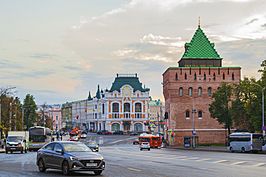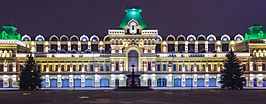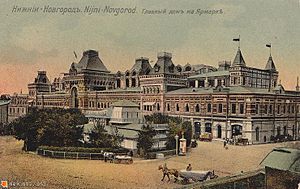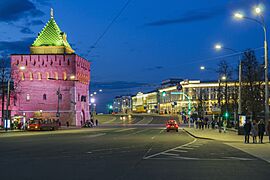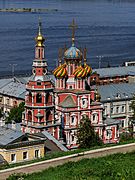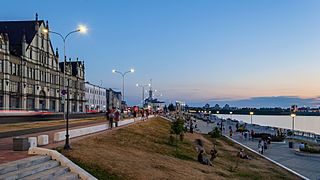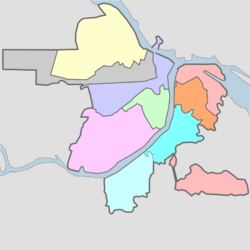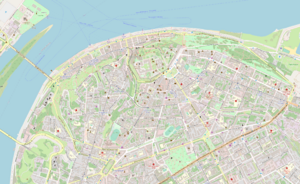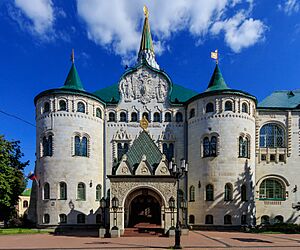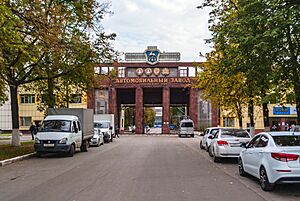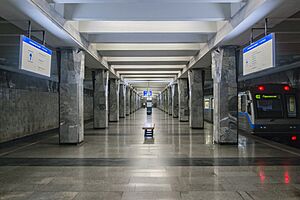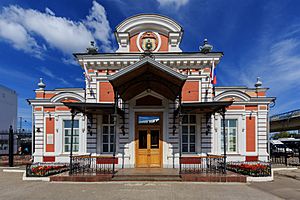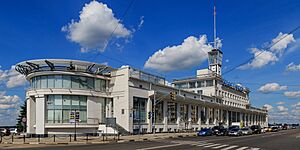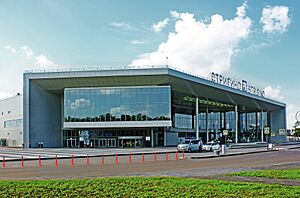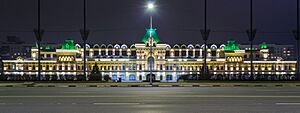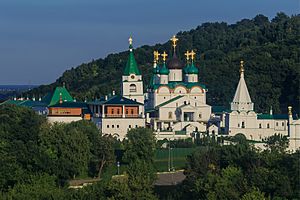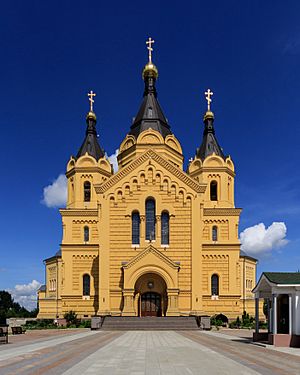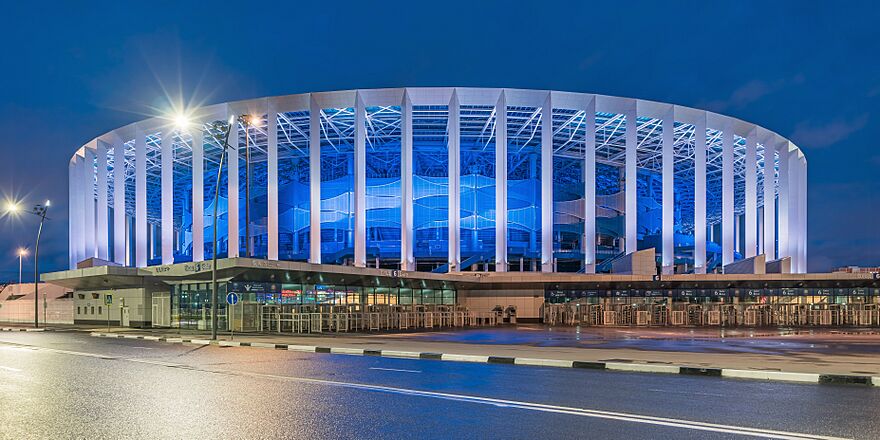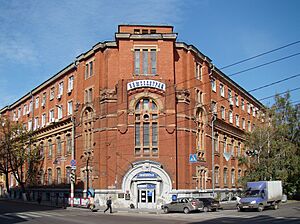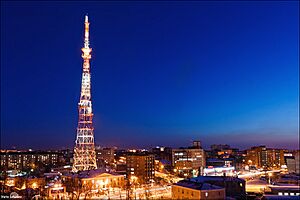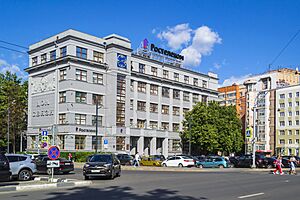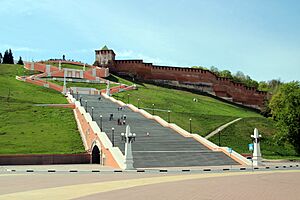Nizhny Novgorod facts for kids
Quick facts for kids Nizhny Novgorod (English)Нижний Новgorod (Russian) Gorky (ru) |
|
|---|---|
| - City - Administrative centre |
|
| [[File:
|250px]] Top-down, left-to-right: Dmitrievskaya Tower of the Nizhny Novgorod Kremlin and Minin and Pozharsky Square, Alexander Nevsky Cathedral and Nizhny Novgorod Stadium, Minin and Pozharsky Monument, GAZ, Chkalov Stairs, Nizhny Novgorod Fair. |
|
|
|
|
| City Day | 3rd Saturday of August |
| Administrative status | |
| Country | Russia |
| Federal subject | Nizhny Novgorod Oblast |
| Administratively subordinated to | city of oblast significance of Nizhny Novgorod |
| Capital of | Volga Federal District |
| Municipal status | |
| Urban okrug | Nizhny Novgorod Urban Okrug |
| Mayor | Yury Shalabaev |
| Representative body | City Duma |
| Statistics | |
| Area | 514.56 km2 (198.67 sq mi) |
| Population (2010 Census, preliminary) |
1,250,619 inhabitants |
| - Rank in 2010 | 5th |
| Population (2021 est.) | 1,263,560 inhabitants |
| Density | 2,430/km2 (6,294/sq mi) |
| Time zone | MSK (UTC+04:00) |
| Founded | 1221 |
| City status since | 1221 |
| Postal code(s) | 603000-603999 |
| Dialing code(s) | +7 831 |
| Official website: http://admgor.nnov.ru/ | |
Nizhny Novgorod (pronounced NIZH-nee NOV-gə-rod) is a big city in Russia. It's the main city of the Nizhny Novgorod Oblast and the Volga Federal District. The city sits where two important rivers, the Oka and the Volga, meet in Central Russia. Over 1.2 million people live here, making it the sixth-largest city in Russia. It's also the second-biggest city along the Volga River.
Nizhny Novgorod is a key place for business, transportation, science, education, and culture in Russia. It's also a major spot for river tourism. You can find many universities, theaters, museums, and churches in the old part of the city.
The city was started on February 4, 1221, by Prince George II of Vladimir. In 1612, two heroes, Kuzma Minin and Prince Dmitry Pozharsky, gathered an army here. They helped free Moscow and all of Russia from Polish and Lithuanian forces. Later, in 1817, Nizhny Novgorod became a huge trading center in the Russian Empire. A big exhibition was held here in 1896.
During the Soviet times, the city grew into an important industrial hub. It was known as Gorky back then. The famous Gorky Automobile Plant was built during this period. People even called the city "Russian Detroit" because of its car industry. In 1985, the Nizhny Novgorod Metro (subway system) opened. The city got its original name, Nizhny Novgorod, back in 1990.
The Kremlin is the historic heart of the city. It houses important government offices. People from Nizhny Novgorod are called Nizhegorodians. The city was also one of the host cities for the 2018 FIFA World Cup.
Contents
- A Look at Nizhny Novgorod's History
- City Government and Layout
- People of Nizhny Novgorod
- Geography and Climate
- Economy and Industry
- Getting Around Nizhny Novgorod
- Main Sights and Attractions
- Education in Nizhny Novgorod
- Sports in Nizhny Novgorod
- Media and Communication
- Famous People from Nizhny Novgorod
- Sister Cities
- Images for kids
- See also
A Look at Nizhny Novgorod's History
How Nizhny Novgorod Got Its Name
The city was first called just Novgorod, meaning "Newtown." But there was another, older city named Novgorod to the west. To tell them apart, people started calling this city "Novgorod of the Lower lands," or "Lower Newtown." It was called "lower" (nizhniy) because it's located downstream from other Russian cities like Moscow.
From 1932 to 1990, the city was known as Gorky.
Medieval Princes and a Stronghold
Nizhny Novgorod began as a small wooden fort on a hill in 1221. Prince Yuri II of Vladimir built it where the Volga and Oka rivers meet. It was the easternmost point where East Slavs lived for a long time.
The fort faced many attacks from the Mordvins. A big attack in 1229 was stopped. After Prince Yuri II died in 1238, the Mongols took over the fortress. Later, it became a key fort for protecting the borders. The two rivers formed a natural defense around it.
Nizhny Novgorod, like Moscow and Tver, was a new town that wasn't destroyed during the Mongol invasion of Kievan Rus'. It grew into an important political center. In 1264, it joined the Vladimir-Suzdal Principality. In 1350, it became the capital of the powerful Suzdal Principality. Grand Duke Dmitry Konstantinovich wanted his capital to be as grand as Moscow. He built a stone fortress and churches. A very old book, the Laurentian Codex, was written for him in 1377.
A City of Forts and Heroes
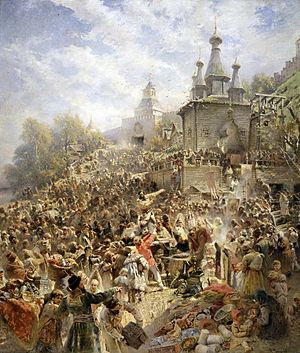
In 1392, Nizhny Novgorod became part of the Grand Principality of Moscow. The local princes moved to Moscow. After being burned by the Crimean Tatar chief Edigu in 1408, the city was rebuilt. Muscovites saw it as a strong fort in their wars against the Tatars. The huge red-brick Kremlin was built from 1508 to 1511. It was strong enough to survive Tatar attacks in 1520 and 1536.
In 1612, a local merchant named Kuzma Minin and Prince Dmitry Pozharsky gathered a "national militia" here. This army drove the Polish troops out of Moscow. This ended a difficult time in Russian history called the “Time of Troubles”. The main square in front of the Kremlin is named after Minin and Pozharsky. Minin's remains are buried in the Kremlin. In 2005, a copy of the statue of Minin and Pozharsky was placed in front of St John the Baptist Church.
Over the next century, the city became rich from trade. The Stroganovs, a very wealthy merchant family, made it their base. A special style of architecture and icon painting, called the Stroganov School, developed here.
The city's coat of arms shows a red deer. The modern one, from 2006, also has a gold crown.
A Hub for Trade
In 1817, the famous Makaryev Fair moved to Nizhny Novgorod. Millions of visitors came each year. By the mid-19th century, the city was known as the main trade capital of the Russian Empire. Important inventions were shown at the All-Russia industrial and art exhibition in 1896. These included the world's first radio receiver by Alexander Popov.
The Sormovo Iron Works was the biggest factory. Other industries also grew. By the early 1900s, the city was a top industrial center. Henry Ford helped build a large truck and tractor factory (GAZ) in the late 1920s.
The Soviet Era
Before 1917, there were no permanent bridges over the Volga or Oka rivers. Bridges were built only for the trade fair. The first bridge over the Volga was finished in 1927.
Maxim Gorky, a famous writer, was born in Nizhny Novgorod in 1868. The city was renamed Gorky in 1932 when he returned to the Soviet Union. The city kept this name until 1990. His childhood home is now a museum.
During World War II, from 1941 to 1943, German forces attacked Gorky from the air. They tried to destroy the city's factories, which made military equipment. These attacks were some of the strongest in the Soviet Union during the war.
For much of the Soviet era, the city was closed to foreigners. This was to protect secret military research and production sites. Even street maps were not sold until the mid-1970s. In 1970, the city received the Order of Lenin award. The famous scientist Andrei Sakharov lived here from 1980 to 1986. This was to limit his contact with people from other countries. The city became open again when it got its original name back in 1990. On November 20, 1985, the first part of the subway opened.
Modern Times
The 800th anniversary of Nizhny Novgorod was celebrated on August 21, 2021. It honored the city's long history and its famous people. The celebration ended with a big gala show. Vladimir Putin attended the event. The Central Bank of Russia even made special coins to mark the anniversary.
-
The Spit (where the Oka and Volga Rivers meet)
-
Lower-Volga River embankment
City Government and Layout
Nizhny Novgorod is the capital of the Volga Federal District and Nizhny Novgorod Oblast. It is a "city of oblast significance," meaning it has a special status similar to a district.
The Oka River divides Nizhny Novgorod into two main parts. The Upper City (Nagornaya chast) is on the hilly eastern side of the Oka. It has three of the city's eight districts:
- Nizhegorodsky (where the Kremlin and historic center are)
- Prioksky
- Sovetsky
The Lower City (Zarechnaya chast) is on the flatter western side of the Oka. It has five districts:
- Avtozavodsky (built around the Gorky Automobile Plant)
- Kanavinsky (home to the Nizhny Novgorod Fair and the main train station)
- Leninsky
- Moskovsky (where the Sokol Aircraft Plant is)
- Sormovsky (where Krasnoye Sormovo and the Volga Shipyard are)
All of the Lower City was added to Nizhny Novgorod between 1929 and 1931.
People of Nizhny Novgorod
| Historical population | ||
|---|---|---|
| Year | Pop. | ±% |
| 1897 | 90,000 | — |
| 1926 | 221,544 | +146.2% |
| 1939 | 643,689 | +190.5% |
| 1959 | 941,962 | +46.3% |
| 1970 | 1,170,133 | +24.2% |
| 1979 | 1,344,474 | +14.9% |
| 1989 | 1,438,133 | +7.0% |
| 2002 | 1,311,252 | −8.8% |
| 2010 | 1,250,619 | −4.6% |
| 2021 | 1,228,199 | −1.8% |
| Source: Census data | ||
Nizhny Novgorod has a population of about 1.2 million people. This makes it the sixth-largest city in Russia. Most of the people (94.8%) are Russians. Other groups include Tatars, Armenians, Azerbaijanis, Ukrainians, and Jews.
Geography and Climate
Time Zone
Nizhny Novgorod uses Moscow Standard Time (MSK). This is 3 hours ahead of UTC. There is no daylight saving time.
Weather
The climate here is continental, meaning it has cold winters and warm summers. Winters last from late November to late March, with snow covering the ground. Average temperatures are around +19°C (66°F) in July and -9°C (16°F) in January. The average yearly temperature is +4.8°C (40.6°F).
Nizhny Novgorod gets about 1,775 hours of sunshine each year. It's often cloudy in winter, but clearer in spring and summer. Snow usually starts in October and melts by mid-April. Summers are warm, with average temperatures between +15°C (59°F) and +20°C (68°F). The highest temperature ever recorded was +38.2°C (100.8°F) in 2010.
| Climate data for Nizhny Novgorod (1991–2020, extremes 1835–present) | |||||||||||||
|---|---|---|---|---|---|---|---|---|---|---|---|---|---|
| Month | Jan | Feb | Mar | Apr | May | Jun | Jul | Aug | Sep | Oct | Nov | Dec | Year |
| Record high °C (°F) | 5.7 (42.3) |
7.2 (45.0) |
17.3 (63.1) |
26.3 (79.3) |
32.5 (90.5) |
36.3 (97.3) |
38.2 (100.8) |
38.0 (100.4) |
31.0 (87.8) |
24.2 (75.6) |
15.9 (60.6) |
8.5 (47.3) |
38.2 (100.8) |
| Mean daily maximum °C (°F) | −5.9 (21.4) |
−4.8 (23.4) |
1.5 (34.7) |
11.0 (51.8) |
19.3 (66.7) |
22.7 (72.9) |
24.9 (76.8) |
22.6 (72.7) |
16.2 (61.2) |
8.3 (46.9) |
0.1 (32.2) |
−4.3 (24.3) |
9.3 (48.7) |
| Daily mean °C (°F) | −8.6 (16.5) |
−8.0 (17.6) |
−2.2 (28.0) |
6.1 (43.0) |
13.5 (56.3) |
17.3 (63.1) |
19.7 (67.5) |
17.4 (63.3) |
11.7 (53.1) |
5.0 (41.0) |
−2.1 (28.2) |
−6.7 (19.9) |
5.3 (41.5) |
| Mean daily minimum °C (°F) | −11.1 (12.0) |
−10.7 (12.7) |
−5.2 (22.6) |
2.2 (36.0) |
8.6 (47.5) |
12.6 (54.7) |
15.1 (59.2) |
13.2 (55.8) |
8.3 (46.9) |
2.5 (36.5) |
−4.0 (24.8) |
−8.9 (16.0) |
1.9 (35.4) |
| Record low °C (°F) | −41.2 (−42.2) |
−37.2 (−35.0) |
−28.3 (−18.9) |
−19.7 (−3.5) |
−6.9 (19.6) |
−1.8 (28.8) |
5.1 (41.2) |
0.9 (33.6) |
−5.5 (22.1) |
−16.0 (3.2) |
−30.9 (−23.6) |
−41.4 (−42.5) |
−41.4 (−42.5) |
| Average precipitation mm (inches) | 50 (2.0) |
40 (1.6) |
40 (1.6) |
40 (1.6) |
42 (1.7) |
73 (2.9) |
75 (3.0) |
68 (2.7) |
59 (2.3) |
67 (2.6) |
52 (2.0) |
59 (2.3) |
665 (26.2) |
| Average extreme snow depth cm (inches) | 31 (12) |
43 (17) |
40 (16) |
5 (2.0) |
0 (0) |
0 (0) |
0 (0) |
0 (0) |
0 (0) |
1 (0.4) |
6 (2.4) |
16 (6.3) |
43 (17) |
| Average rainy days | 5 | 4 | 5 | 13 | 17 | 19 | 18 | 18 | 18 | 18 | 10 | 6 | 151 |
| Average snowy days | 28 | 24 | 18 | 7 | 1 | 0.1 | 0 | 0 | 1 | 8 | 20 | 26 | 133 |
| Average relative humidity (%) | 86 | 81 | 74 | 64 | 60 | 69 | 70 | 74 | 79 | 82 | 87 | 86 | 76 |
| Mean monthly sunshine hours | 37.6 | 74.7 | 152.7 | 217.0 | 294.6 | 307.0 | 317.1 | 261.3 | 158.7 | 84.7 | 39.5 | 23.4 | 1,968.3 |
| Source 1: Pogoda.ru.net | |||||||||||||
| Source 2: NOAA | |||||||||||||
Economy and Industry
Nizhny Novgorod has always been important for trade. In 1822, the huge Nizhny Novgorod Fair opened. It made the city a major center for trade in Russia and with other countries.
During the Soviet era, Gorky (Nizhny Novgorod) became a huge industrial city. Factories that made machines, processed metal, and worked with information technology were very important. The Gorky Automobile Plant was a key factory.
Today, trade in Nizhny Novgorod is mostly about retail stores. Many shopping centers have been built. In 2008, the Lobachevsky Plaza business center was built in the city center. In 2019, Nizhny Novgorod was named the best city in Russia for quality of life. This was based on things like how much people could buy, safety, healthcare, and traffic.
Technology and IT
Nizhny Novgorod is a growing center for the IT (Information Technology) industry in Russia. Many companies here develop software. Intel used to have a large software research and development center in the city.
Many other software companies also work here, especially for telecommunications. The city has 25 research places focused on things like telecommunications and physics. It also has 33 universities, including Nizhny Novgorod State University. Nizhny Novgorod is one of four cities chosen to build an IT-focused technology park. These parks have special rules and tax benefits to help tech companies grow.
Engineering and Factories
Engineering is the most important industry in Nizhny Novgorod. This includes making cars, ships, diesel engines, airplanes, and machine tools. The car industry makes up half of all engineering work.
Some of the biggest factories are:
- JSC “Gorky Automobile Plant” – makes cars, trucks, and armored vehicles.
- JSC “Krasnoye Sormovo” – builds river and sea ships, and submarines.
- JSC “Sokol” – makes planes and jets.
- PJSC “Nizhny Novgorod Machine-building Plant” – produces weapons and oil equipment.
- JSC “Hydromash” – makes hydraulic parts and landing gear.
- JSC “Nitel” – produces TV sets.
- JSC “RUMO” – makes diesel generators.
- JSC “Krasny yakor” – creates anchor chains.
- OKBM Afrikantov – builds nuclear reactors.
Getting Around Nizhny Novgorod
City Transport
You can get around the city using trams, marshrutkas (shared taxis), buses, and trolleybuses. There are also electric and diesel trains that go to the suburbs.
Subway System
The Nizhny Novgorod Metro is an underground subway system. It opened in 1985 and now has two lines with 15 stations. It connects to the main train station and carries many passengers every day.
City Rail
The Nizhny Novgorod City Rail is a train network within the city. It works with the subway to create a fast transport system. It has two lines and started in 2013.
Trains
The Gorky Railway is based in Nizhny Novgorod. It manages thousands of kilometers of train lines. Nizhny Novgorod has been connected to Moscow by railway since 1862. You can take overnight trains to many cities like Moscow, Saint Petersburg, and Kazan. Fast trains can get you to Moscow in less than four hours. From Nizhny Novgorod, you can also travel eastward on the Trans-Siberian Railway to cities in the Urals and Siberia, and even to Beijing.
Fast Strizh trains run between Nizhny Novgorod, Moscow, and Saint Petersburg. Local trains called elektrichka connect Nizhny Novgorod to nearby towns.
Water Travel
Nizhny Novgorod is a major center for shipping on the Volga River. In summer, cruise ships travel between Nizhny Novgorod, Moscow, Saint Petersburg, and Astrakhan. Hydrofoils (fast boats) also run on the Volga. In 2019, river travel within the region started again.
Roads
The city is on the Russian highway M-7, which connects Moscow, Nizhny Novgorod, Kazan, and Ufa. It's also a hub for other regional highways.
Bus Stations
Nizhny Novgorod has several bus stations for travel between cities. The Kanavino Bus Station is near the Moscow Railway Station and serves routes to the west. The Scherbinki Bus Station is south of the city center and serves routes to the east and south.
Cable Car
In 2012, a cableway opened, connecting Nizhny Novgorod and Bor. It's about 3.5 kilometers (2.2 miles) long. It has the longest unsupported span over water in Europe. The cable car offers amazing views and is a popular tourist attraction.
Air Travel
Nizhny Novgorod is served by Strigino International Airport. It has direct flights to major Russian cities and the Middle East. A new airport terminal opened on December 29, 2015.
Main Sights and Attractions
Much of the city center has buildings in the Russian Revival and Stalin Empire styles. The most striking feature is the huge Kremlin (built 1500–1511) with its red-brick towers. Inside the Kremlin, the only old building left is the Archangel Cathedral (1624–1631).
The city has over 600 unique historic and cultural monuments. There are about 200 art and cultural places, including eight theaters, five concert halls, 97 libraries, 17 cinemas, 25 children's education centers, eight museums, and seven parks.
The Fair Grounds
The main building of the fair was built in a classic style. A 3.5-meter (11.5-foot) high dam was built to protect it from floods. Today, the Nizhny Novgorod Fair is an interactive museum. It tells the history of Nizhny Novgorod, including its founding and its role in World War II.
Nizhny Novgorod Art Gallery
The art gallery in Nizhny Novgorod is a large and important museum. It has over 12,000 artworks. You can see works by famous Russian artists like Viktor Vasnetsov and Ivan Aivazovsky. There are also collections of Western European art and Russian avant-garde works.
Churches and Monasteries
Two important medieval abbeys are also here. The Pechersky Ascension Monastery has a five-domed cathedral (1632). The Annunciation monastery has another five-domed cathedral (1649).
Many beautiful churches were built by the wealthy Stroganov family. The Virgin's Nativity Church (1719) is on a central street. The Church of Our Lady of Smolensk (1694–97) is in the former village of Gordeyevka.
Other notable churches include:
- The Transfiguration Cathedral (1822), a huge domed building.
- The Alexander Nevsky Cathedral (1856–1880), built where the Oka and Volga rivers meet. It's the third-tallest cathedral in Russia.
- The Church of the Nativity (1696–1719), one of the most beautiful churches in the city.
- The recently rebuilt Church of the Nativity of John the Precursor (1676–83).
- The Nizhny Novgorod Synagogue (1881–1883) was renovated and reopened around 1991.
Chkalov Stairs
The Chkalov Staircase connects the main square to the river embankments. It was built in the late 1940s. It is the longest staircase in Russia. The staircase starts at the monument to Chkalov near the Kremlin. It has 560 steps if you count both sides. There are two viewing platforms along the way. At the bottom, there is a monument to the Hero boat.
Nizhny Novgorod Stadium
The international-class Nizhny Novgorod Stadium stands where the Volga and Oka Rivers meet. This stadium hosted six games of the 2018 FIFA World Cup. After the World Cup, it is used for many different sports.
Other Sights
A unique industrial building is the 128 m (420 ft) open-work hyperboloid tower. It was built in 1929 by engineer Vladimir Shukhov as part of a power line crossing the Oka River.
Education in Nizhny Novgorod
Nizhny Novgorod has many educational institutions:
- N. I. Lobachevsky State University of Nizhny Novgorod
- Nizhny Novgorod State Technical University
- Research Medical University of Volga region
- Nizhny Novgorod State University of Architecture and Civil Engineering
- Nizhny Novgorod State Linguistic University
- Nizhny Novgorod State Pedagogical University
- Nizhny Novgorod State Agricultural Academy
- Volgo-Vyatsky Region Civil Service Academy
There are also twenty research institutes in the city.
Sports in Nizhny Novgorod
Several sports clubs are active in the city:
| Club | Sport | Founded | Current League | League Rank |
Stadium |
|---|---|---|---|---|---|
| FC Nizhny Novgorod | Football | 2015 | Russian Premier League | 1st | Nizhny Novgorod Stadium |
| Torpedo Nizhny Novgorod | Ice hockey | 1946 | Kontinental Hockey League | 1st | Trade Union Sport Palace |
| Start Nizhny Novgorod | Bandy | 1932 | Bandy Super League | 1st | Start Stadium |
| BC Nizhny Novgorod | Basketball | 2000 | VTB United League | 1st | Trade Union Sport Palace |
| ASC | Volleyball | 2016 | Major League A | 2nd | FOK Zarechye |
| Sparta | Volleyball | 2000 | Women's Volleyball Supreme League A | 2nd | FOK Zarechye |
| Futbol-Hokkey NN | Futsal | 1996 | Futsal Supreme League | 2nd | FOK Krasnaya Gorka |
2018 FIFA World Cup
Russia hosted the 2018 FIFA World Cup, and six matches were played at the new Nizhny Novgorod Stadium. The stadium is built where the Volga and Oka rivers meet. It can hold 44,899 people.
The stadium hosted these World Cup games:
- June 18, 2018: Sweden vs. South Korea
- June 21, 2018: Argentina vs. Croatia
- June 24, 2018: England vs. Panama
- June 27, 2018: Switzerland vs. Costa Rica
- July 1, 2018: Croatia vs. Denmark (Round of 16)
- July 6, 2018: Uruguay vs. France (Quarter-finals)
During the World Cup, Minin and Pozharsky Square hosted the FIFA Fan Fest. Fans could watch games on a big screen and enjoy food and activities.
Media and Communication
Nizhny Novgorod is a center for TV and radio broadcasting in its region. It has local TV stations, internet services, and print media.
Newspapers
Some popular newspapers in the city include Nizhegorodskaya Pravda, Stolitsa Nizhny, and Nizhegorodsky rabochiy. Nizhegorodskaya pravda is the oldest newspaper in the city.
TV and Radio Stations
One of the first TV channels was NNTV. Another channel is Volga.
Here are some TV channels available in Nizhny Novgorod:
|
|
|
|
Here are some radio stations in Nizhny Novgorod:
|
|
|
|
Famous People from Nizhny Novgorod
Sister Cities
Nizhny Novgorod has many sister cities around the world:
Images for kids
See also
 In Spanish: Nizhni Nóvgorod para niños
In Spanish: Nizhni Nóvgorod para niños


